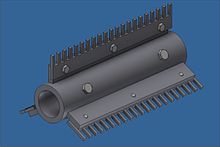Continuous degasser
The continuous degasser (DEG) is a mechanical-electrical component from process engineering . It works in a continuous process and is used for fast and complete degassing and pumping of medium to high viscosity liquids and mixtures under vacuum . The DEG is used for the preparation and cleaning of media such as epoxy resins , polyurethane resins (PU), silicone , polyester resins and their hardener components , in potting systems in the electrical industry and other branches of production and in the chemical industry.
Function and principle
Basically, liquid materials can be degassed particularly efficiently on their surface by means of a vacuum (pressure reduction). Existing gas bubbles expand and rise to the surface. The thinner the material to be degassed, the shorter the distance that the gas covers to the surface before it emerges from the material, and the desired degree of degassing can be achieved correspondingly quickly.
The continuous degasser uses this principle and uses a mechanical process to increase the surface area. The degassing device consists of a horizontally inclined cylinder, the inner wall of which forms the degassing surface. The material to be degassed enters the cylinder at the higher end and flows through the incline to the lower end, where it leaves it again for further processing. The material is applied to the inner wall of the cylinder in evenly thin layers by means of an internal driven shaft with combs or spatulas and is continuously degassed by the vacuum. The permanent rotary movement constantly creates new surfaces and ensures uniform, intensive and, above all, rapid degassing.
The shaft can be equipped with different combs and spatulas in order to achieve optimal results depending on the viscosity of the materials. The inclination of the cylinder can also be adapted to the viscosity of the medium to be degassed: the more viscous it is, the steeper the incline.
The performance of a DEG is determined by the volume to be processed per unit of time (hour, day, month) and is determined by the size of the DEG. The flow rate can be influenced by lowering the viscosity by increasing the temperature or by changing the angle of incline of the continuous degasser. Multi-stage continuous degassers (connected in series) increase the processing quality and are suitable for fast throughput and large quantities.
Continuous degassers have compared to z. B. vacuum mixers that work in batch processes , the advantage that a continuous material throughput is possible. A backmixing of media that has already been degassed with material that has not yet been processed is not possible due to the design.
A sensible use of continuous degassers is only possible if the upstream and downstream process steps such as the mixing of the components and the actual processing of the material also take place continuously. Another disadvantage is that the dwell time in the degasser is not defined directly, but can only be adjusted indirectly via the incline of the degasser and thus the flow rate of the medium.
history
The continuous degasser described here is a process technology invention based on the further development of various mixer and degassing systems. In 1992 a patent was successfully submitted by Hedrich GmbH to the German Patent Office and granted in 2003. Since 1993, the process has been modified and used in various industries worldwide.
Individual evidence
- ↑ Patent DE4222695 : Process and device for continuous degassing of cast resin. Registered on July 10, 1992 , published on January 30, 2003 , applicant: Wilhelm Hedrich Vakuumanlagen GmbH & Co. KG, 35630 Ehringshausen, inventor: Häuser, Erhard.
literature
- Raimund Stierli: Epoxy casting and impregnating resins for the electrical industry. In: Kunststoff-Handbuch. Volume 10: Wilbrand Woebcken (Ed.): Duroplaste. 2nd, completely revised edition. Hanser, Munich et al. 1988, ISBN 3-446-14418-8 , pp. 510-527.
- FA Streiff: Static mixing. In: Matthias Kraume (Ed.): Mixing and stirring. Basics and modern procedures. Wiley-VCH, Weinheim 2003, ISBN 3-527-30709-5 , pp. 197-220.

